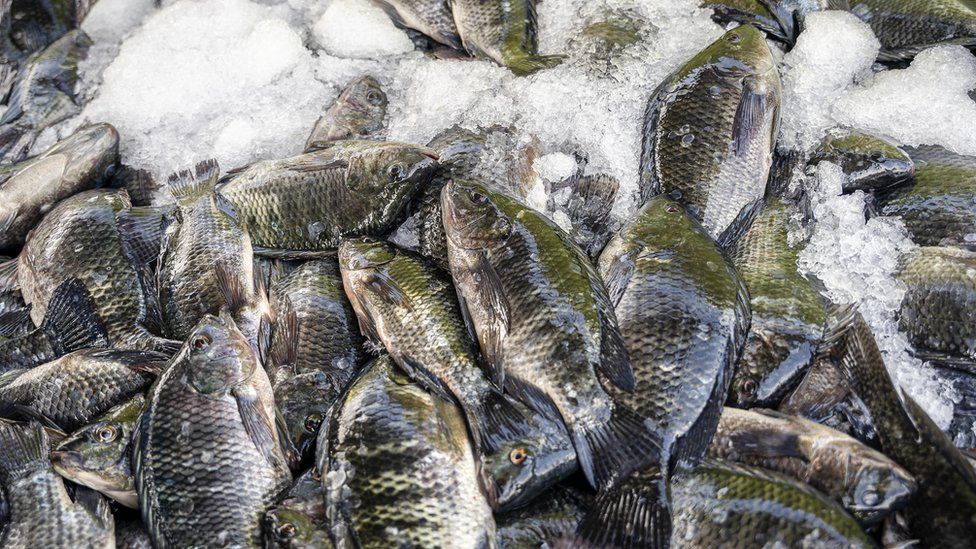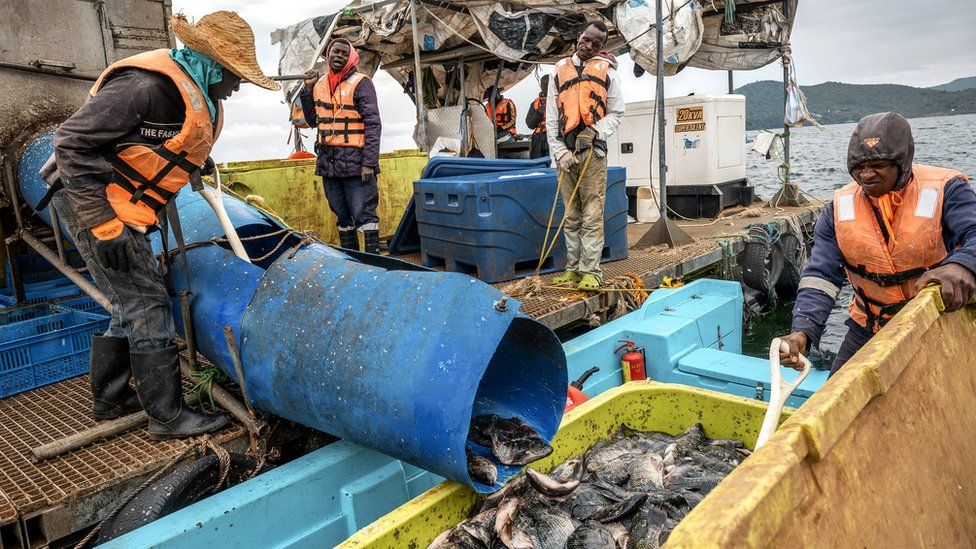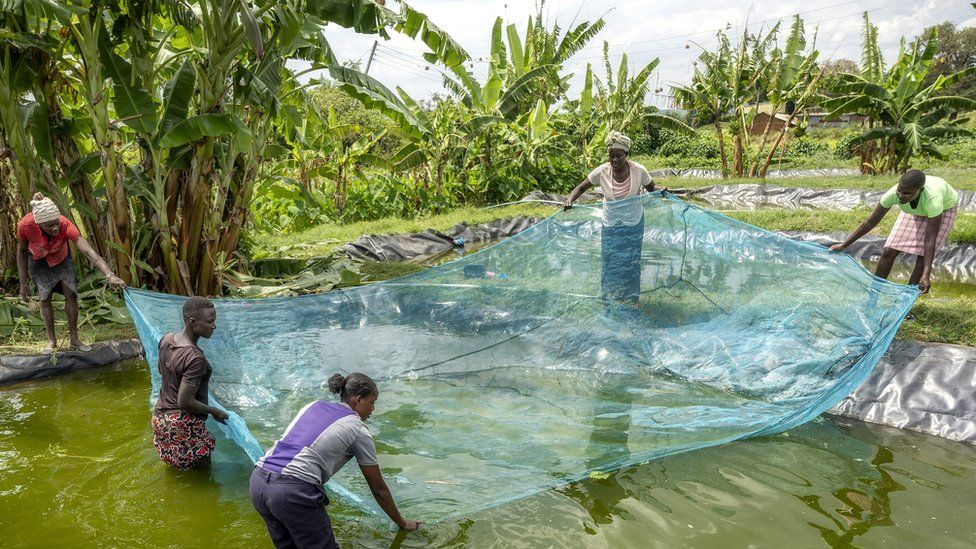Despite risks fish farms are booming in Africa

“It was horrible,” says Allan Ochieng of the disaster that struck the fish farmers of Lake Victoria late last year.
Thousands of fish were killed when Africa’s largest lake experienced a natural and recurring phenomenon known as upwelling.
It happens when deep waters mix with surface water, causing a sudden depletion of dissolved oxygen in the water, killing the fish.
Some of the farmers believe that raised levels of algae, or pollution might have played a role.
Mr Ochieng lost all his 120,000 tilapia, of which half were almost ready for harvest. Many other farmers experienced similar losses.
Along with three partners, the entrepreneur owns 24 cages, close to Ogal beach on the Kenyan shoreline, which cost them around $100,000 (£80,000). They spent another $185,000 on the baby tilapia, feed and labour.
“Cage fish farming comes with enormous risks but can also be extremely profitable,” says Mr Ochieng, who is determined to continue.
As its name suggests, cage aquaculture involves raising fish in a net cage. It’s become one of the fastest growing food sectors in sub-Saharan Africa, as wild fish stocks have declined and the demand for fish has risen.
The number of cages grew from nine in 2006 to more than 20,000 in 2019, according to a study published in Nature Food.
In East Africa, between 2017 and 2021, the industry tripled in size, according to a report by Gatsby Africa.

Yalelo Zambia is the biggest tilapia producer in Sub-Saharan Africa, producing 25,000 tonnes of fish combined at its facilities on Lake Kariba in Zambia and on the Ugandan side of Lake Victoria.
The company’s chief executive, Ulric Daniel, says it’s an increasingly high-tech business.
“As we deal with a product that we can’t see, once it’s under water, we have to rely heavily on technology to measure what is actually happening under the surface,” the chief executive tells the BBC. He adds that cage fish farming is way more data rich than, for example, the poultry industry.
He says all that data can help mitigate farming disasters like last year’s.
“Upwelling can happen rather suddenly, but some indicators can predict it coming. Therefore, we daily measure the dissolved oxygen, the pH values and the ammonia content in the water,” Mr Daniel says.
“Once we see first signs of upwelling, we can reduce the number of fish in a cage to prevent mortality.”
Victory Farms, which is Kenya’s biggest producer of caged fish, also collects a lot of data.
“We measure multiple depths and locations to assess underwater activity and biology, assess algae in the lake as an indicator for upwelling, and, in case of reduced dissolved oxygen levels, we check water currents as well as the level of algae build-up on the nets of the cages,” says chief executive Joseph Rehmann.
“With a history of seven years of data, we can now usually predict whether there’s a high, medium or low risk for upwelling. In case of high risk, we change stocking densities, reduce feeding, and slow or stop fish handling, both to reduce stress.”

Victory Farms has also developed technology to cut losses during the transport of live eggs to the hatchery.
It developed a mobile incubation system, which keeps the eggs in motion in oxygenated water.
The technology emerged from a project to construct brood stock ponds on plots in the nearby community.
In return participants are paid for the harvested fish eggs, which are then transported to Victory Farms own ponds.
Such innovations are beyond reach of the growing number of small-holder farmers who have ventured into cage fish farming.

“Although measuring oxygen levels in cages is extremely important, most small holders don’t do it as they cannot afford the required equipment, which costs more than $1,000,” says Dave Okech, chairman of the Cage Fish Farmers Association Kenya.
Another problem, according to Mr Okech, is the lack of knowledge among many of the new farmers. “As a result, some put their cages in too shallow waters, which might lead to water pollution, and can result in higher mortalities in the case of upwelling.
“Some entrepreneurs also use low quality feed which sinks, which negatively affects the ecosystem and causes losses, since tilapia feed on floating pellets,” Mr Okech adds.
He thinks more precise feeding would lead to healthier fish and save farmers money.
His company, AquaRech, is currently working on a system that will monitor the water temperature in cages.
He says that is a key piece of data, as colder temperatures make it harder for tilapia to digest what they have eaten.
Armed with that information, his system can advise farmers on exactly how much feed to use.
“We need these kinds of innovations to professionalize the sector and make it more productive and beneficial to those involved,” the Kenyan entrepreneur adds.


However, some are worried about the rapidly growing industry. There’s concern over the considerable amount of uneaten feed and fish faeces that accumulates under the cages, and their affect on water quality.
“The presence of these environmental issues underscores the importance of responsible fish cage placement, in deep enough waters with enough water circulation,” says Chrisphine Nyamweya, research scientist at the Kenya Marine and Fisheries Research Institute.
Joe Rehmann, from Victory Farms, says his company and government officials regularly test the water conditions.
“So far, we have not had any issues with fish carrying capacity,” he says.
He points out that overfishing has depleted Lake Victoria’s population of wild fish.
“If Victory Farms today has 3,000 tons of biomass, we are adding to the nutrient load, but well within the natural carrying capacity that existed before human-led overfishing depleted the lake.”
